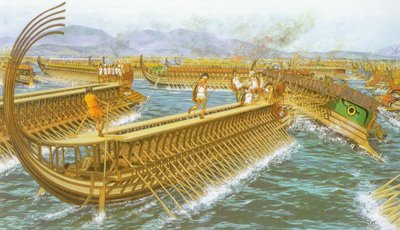The Greek Navy
In spite of the relative inefficiency of classical naval warfare, it played a very important part in Mediterranean military history. The Battle of Salamis [above] is considered one of the most decisive battles the world has ever seen (we will discuss Salamis later).
The 'standard' Greek ship such as those depicted above was the trireme. The trireme had two available methods of propulsion (unless Poseidon felt inclined to provide some form of divine transport), the sail or three banks of oars. The term bank refers to 'levels' of oarsmen. Throughout history most nations, including most of Persia, have placed slaves or men of the lower class at the oars, deeming such work dishonourable. Greece, however, selected many of their best to serve below decks. According to the Greeks this was an incredibly honourable task. This probably was part of the reason Hellenic navies were the best in the world at the time:
Good Men + Lots of Training + Excellently Built Ships = The Finest Navy In the World

An Early Greek Vessel
One of the keys to Greek and Mediterranean ship design lies in an oddly shaped bow (front of the ship). The lower part, as shown above juts out under the waterline several metres. This devise was then coated in metal, usually bronze, and, when propelled by the 170 oarsmen of a trireme, could be used to ram the opponents ship. At this point the ten or so Greek Marine Hoplites on board would rush forward under the cover of about four archers to attempt to board the enemy ship.


0 Comments:
Post a Comment
<< Home